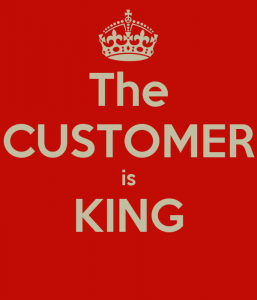If ‘Customer is King’, How Are You Enabling Your ‘King-Makers’?
 Accelerated by the COVID-19 Crisis, disruptive technologies coupled with restricted movement of people and products, have forever altered the business landscape. Consequently, organizations have been scrambling to survive, let alone maintain a semblance of growth in the era of the digital consumer. Leaders seeking to gain the higher-ground are embarking on fast-paced CX strategies, aspiring to make the customer the undisputed king. Nevertheless, what does this strategy really mean to the kingdom (the organization) and its kingmakers (its employees)? Few leaders truly understand the wide-ranging transformation an organization must embrace for this approach to succeed.
Accelerated by the COVID-19 Crisis, disruptive technologies coupled with restricted movement of people and products, have forever altered the business landscape. Consequently, organizations have been scrambling to survive, let alone maintain a semblance of growth in the era of the digital consumer. Leaders seeking to gain the higher-ground are embarking on fast-paced CX strategies, aspiring to make the customer the undisputed king. Nevertheless, what does this strategy really mean to the kingdom (the organization) and its kingmakers (its employees)? Few leaders truly understand the wide-ranging transformation an organization must embrace for this approach to succeed.
The major reason for failure is down to the struggle of assimilating the customer perspective into every function, level, role and organism within the organization. Having observed a range of approaches, we’ve discovered the most successful CX strategies arise from four mutually supporting principles — each of which are driven from the top, but supported zealously across all levels. A closer look at each principle offers lessons for leaders seeking to create and sustain their CX capabilities.
Principle 1: Build for Customercentric Talent
Organizational identity will always be defined by its people. CX outwardly amplifies this, but with less control for the organization. Leaders need to determine the capabilities required in delivering a branded CX that aligns with the company’s promise. As organizations seek to attract and retain talent, they must consider what qualities and attributes each position, team and function requires. For example, will competencies around collaboration, responsiveness, and service agility outweigh the need for more resilient and competitively independent contributors? How will part-time, gig or outsourced staff give or take from this equation? Whether developing and/or acquiring talent, deciphering your workforce needs provides the bedrock for any compelling CX.
Principle 2: Bind your Purpose and Promise
Visit most corporate reception areas and you will find powerful and inspiring articulation of mission, purpose, and vision. While these statements offer a window into an organization’s aspirations, they often fail to translate into a differentiated or practical CX. To operationalize the impact of these statements, leaders need to consider:
- What are our customers telling us? Data analytics provides a real-time window into the customer’s rational and emotional needs like never before. This is more important than ever given the increased sovereignty of the digital-customer.
- How do we measure the delivery of our customer promise? Companies can deliver a their branded CX by aligning day-to-day activities with tangible business goals through continuous measurement of performance and behavior, tied to practical customer service values.
- How can we harness these analytics to drive the right behaviors and processes? The ease and power of today’s CX software provides unprecedented utility in synthesizing and socializing such data, in a manner that must be both actionable and simple for all.
These questions not only help leaders start to frame and align the organization’s purpose and customer promise, they also set the tone for how they will be brought to life and measured.
Principle 3: Know and Grow with your Data
Understanding the insights and trends from the field is an enticing proposition for any organization, especially as the world navigates the disruptive impact of COVID-19. However, this alone will not ensure a successful CX. The data analytics captured must continuously help inform how your organization’s hardware (i.e. operating model, structure, and performance metrics) interacts with your software (i.e. behaviors, informal networks and engagement).
Ensuring that both the hardware and software elements of your organization are well-synchronized, creates the fertile ground for an empowered and accountable culture. Vital for any branded CX, these qualities naturally require strong organizational maturity. Here, data is critical in supporting the decision-making process for leaders when: acquiring the required talent; and setting them up to operate effectively within the purpose-designed role/ function, as they respond to customer needs with autonomy and purpose. Data helps you jump-start this virtuous cycle where the employee-customer relationship is tracked, but also supported by technology and leadership.
Principle 4: Lead from the Customer Front Lines and not just the Dashboard
Leaders should not solely be fixated on performance metrics in absence of the drivers of these metrics. Hence, a successful CX strategy also demands leaders to:
- Role-model the desired behavior through action, conversation, and professional development; reinforcing what the organization stands for and how this drives the CX
- Celebrate best-in-class performers when it comes to both behavior and performance
When leaders promote and socialize their customer promise, it sends a strong signal throughout the organization recognizing King Customer as central to its existence. Likewise, distinguishing standout employees, or specific interactions as examples, also helps generate cultural momentum.
A robust CX strategy offers organizations an organic and sustainable avenue to better results. Channeled correctly, the binding of technology and talent helps deliver potentially unsurpassable competitive advantages through the CX. However, these strategies don’t flourish on their own. Leaders who better understand these four principles as well as the resistance and challenge that comes with the territory, will have the edge. The investment and effort in such a journey could prove to be the difference between growth or stagnation for companies trying to stay afloat in the most disruptive era of our time.
